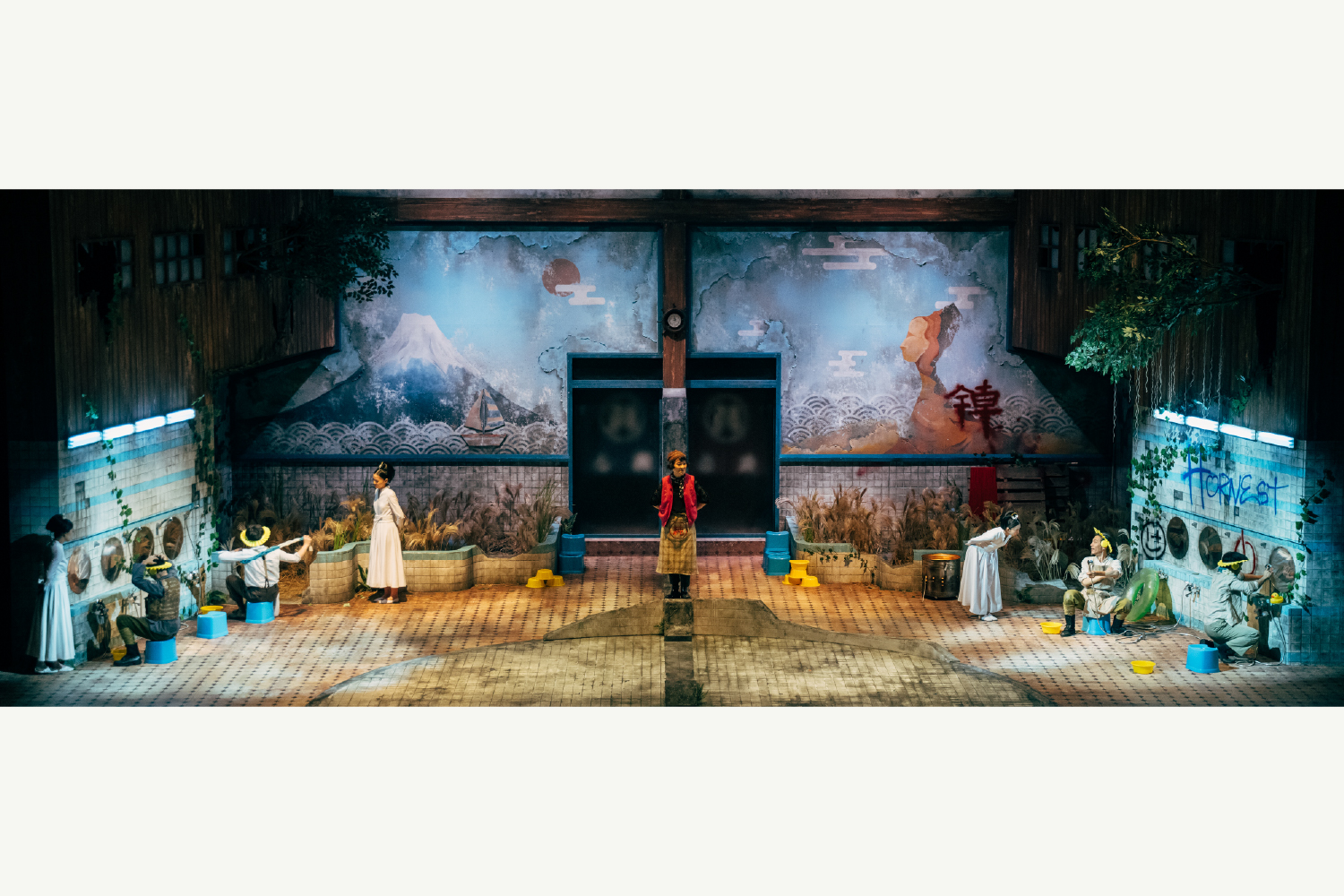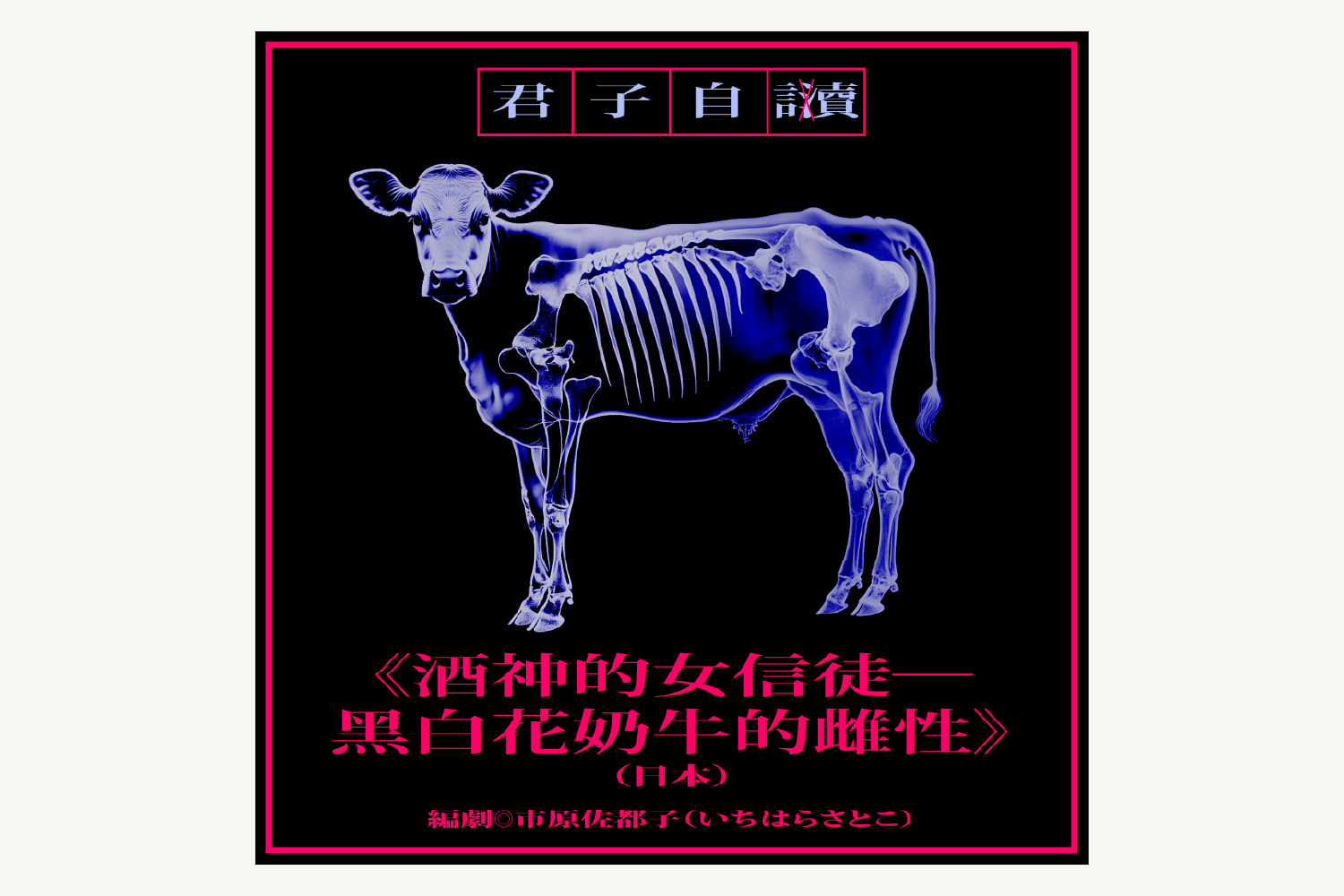ARTICLES

©igaki photo studio
A Review of Yasuko Yokoshi’s shuffleyamamba (Toyooka Performance)
Kyoko Iwaki (Theater Performance Studies)
2020.2.11
Translated by Rebecca Copeland
Artistic Direction, Choreography, Media Concept: Yasuko Yokoshi
Co-direction, Music, Performance: Gelsey Bell
Dramaturge: Jun Tsutsui(dracom)
Choreography, Guest Artist: Norico Sunayama (dumb type)
Co-choreography, Performance: Narumi Ueno, Terunobu Osaki, Haruna Shibuya, Juri Nisihoka, Sawami Fukuoka
Period of Stay: 2019 3.3 (Sun.) - 3.17 (Sun.) & 9.14 (Sat.) - 10.7 (Mon.)
Date of Performance: 2019.10.5 (Sat.) - 6 (Sun.)
Venue: Izushi Eirakukan
Before beginning the detailed review of the artwork, it is important to provide some background information on choreographer Yasuko Yokoshi’s career. In 1981 Yokoshi traveled to the United States to work as a bilingual secretary. However, her future was taken in an unexpected direction as if guided by some transcendent power. Deeply impressed by Framework, a 1984 dance piece choreographed by David Gordon, an earlier member of the 1960s Judson Dance Theater, Yokoshi set her sights on becoming a choreographer. Subsequently, she began to work in the postmodern dance idioms, which were free in form, concept, and physicality. That is, it was overtly different from the elitist and classicist lineage of Western ballet as well as from those American modern dance which tended to deify founder Martha Graham. As is often the case for an artist of color working in a Western country, Yokoshi had no choice but to confront her identity as a “Japanese.” In the US, she had to develop a set of languages to explain her Japaneseness that would be persuasive enough to fellow Americans. And so, as a natural consequence, in order to distinguish her dance expression from that of ballet or modern dance, from the 2000s, she began to study with the sixth-generation headmaster of the Fujima School, Fujima Kanjirō and added kabuki to her repertoire. Once she had mastered the basics of how to bend at the waist (koshi o oru) and how to walk with gliding steps (suri ashi), she presented a suodori, or unembellished kabuki dance, in a series of choreographic pieces that incorporated the dance histories and techniques of both Japan and the West: what we when we (2006), Tyler Tyler (2010), and BELL (2013). Thus, shuffleyamamba can be seen as the culmination of Yokoshi’s eclectic mixing of East and West.
Some may think that it is too facile for a Japanese performer to discover their identity through an exploration of Japanese traditional art forms. And, indeed, there are Japanese artists working mainly abroad, who create their own unique dance vocabulary solely by focusing intently on their inner selves. But the one unavoidable difference between Yokoshi and these other ‘purist’ choreographers is that the former is one of the very few Japanese female artists who work transnationally in the field of contemporary dance. Although some may disagree, I believe that still many Japanese women, whether consciously or otherwise, develop their personalities by responding to the gaze of others. In other words, their sense of self is formed as a result of their often-stultifying encounter with the social pressure. And this responsiveness, or, more still, passive form of communication, is quite compatible with the practice of the traditional Japanese arts, which requires a complete denial of the self rather than the cultivation of an individual expression. For example, midway through shuffleyamamba, we come to a scene where we hear a voice transmitted through a transistor radio urging a student of dance to practice this kind of blind devotion—the kind of instruction Yokoshi probably received from her suodori teacher: “You don’t possess time for yourself. All the time you have is given to me. Taking a bath and going to the bathroom is yours. Everything else is mine.” The idea that the perfection of art is contingent upon this kind of life-defying passivity, or absolute subjectivity, is antithetical to the modern Western white-male-oriented dance that egotistically regards the true value of art as liberating the self from social norms without succumbing to anything outside of the self.
The passivity of classical Japanese dance often leads to it being described as “feminine,” while the autonomy of modern and contemporary western dance leads to the impression of it as more “masculine.” Specifically, because she appreciates this intrinsic contradiction, Yokoshi introduces a clear outsider to the stage, a male performer who most likely has never had any classical dance training and whose body is “too uninhibited.” (This is Mika Kurosawa’s disciple, Terunobu Osaki.). He squeezes his pudgy body into a unitard meant to resemble the costumes used in Merce Cunningham’s Summer Space, and repeats his joyfully random steps that seem to fall somewhere between a “salaryman’s” efforts at dancing as a hobby and those of a performer of contemporary dance. His unhinged routine sharply contrasts the controlled movements of the three women on stage (Narumi Ueno, Haruna Shibuya, and Juri Nishioka) who perform the role of a dance class. They execute a combination of movements from ballet, modern dance, and Japanese classical dance with strict control, their faces with almost no expression. Additionally, the male performer asserts from stage about the “freedom” of contemporary dance. “I think it’s just wonderful that we can entertain others by making a complete spectacle of ourselves!” Needless to say, Yokoshi does not herself believe that entertaining others through self-spectacle is automatically worthy of praise. Rather, she has her dancer make this announcement as a way to expose the audience to the pointed criticism this kind of “naïve self-expression” has received and to force the audience to think about it. It seems as though Yokoshi is even saying as follows: Why is it that men can aspire to a self-liberating expression without any reservation, but a woman can only perform “liberation” after she has mastered the social rules that have her constantly negotiating with the opposite sex?
Needless to say, Yokoshi also recognizes that when we say “expose yourself,” the subject of that exposure is often female. For this reason, we will turn the attention of this critique to the fact that when women “expose themselves” it is often for entertaining men, and, thus in turn results in the replication of a negative identity. This critique of performed gender is most clearly revealed in the scene that adopts the song “Rich Man’s Frug” from the film Sweet Charity. The scene begins with Narumi Ueno’s silent entrance, wearing a haori on the upper part of her body and fishnet stockings on the lower. As she processes along the hanamichi with exaggerated coquettishness, it becomes obvious that a woman’s “audacity” is performed in response to the masculine gaze. Anyone with knowledge of the American entertainment industry will automatically think of Bob Fosse’s sexy dance number, with beautiful women in little black dresses and handsome men in perfectly fitted black suits. The pairing of the sexes, with not so much as a thread out of place, mesmerizes his audiences. But this concept of sexiness is born from Fosse’s imagination, a macho choreographer and well-known womanizer. Precisely because she is aware of the way gender is manufactured, the dance that Yokoshi choreographs for these women foregrounds the comical ridiculousness that ensues when women force themselves to act sexy rather than just be their natural sexy selves.
The same can be said for Norico Sunayama’s burlesque dance in the second portion of the performance. Hiding the nakedness of her upper body with giant feather fans, Sunayama teases the audience, her dance revealing her consummate charm while never giving way to a sense of lewdness. That is, firstly, because Eirakukan is precisely not a burlesque theater, and, secondly, because the audience is not gathering to be entertained by a named woman, the outcome of the performance is alienation rather than absorption. Rather than watching raptly with bated breath, the audience can engage in a more critical appreciation of the body with eyes now awakened to the gendered nature of performance. And of course, alienated effects suits comedy more so than tragedy. Precisely because of her familiarity with this kind of dramaturgy, Yokoshi was able to subtly objectify the works most recognized as tragedies in the history of performance in both the East and the West, namely, the ballet Giselle and the nagauta Dōjōji. In the process, the choreographer liberates those women from the “tragic curse of forbearance” to which they have been shackled by their gender.
The clearest expression of this women’s liberation is demonstrated by American vocalist Gelsey Bell whose repertoire ranges from Broadway performances to experimental music and even includes a nagauta that she has learnt from master Kineya Sanshichirō. Towards the end of shuffleyamamba, Bell provides a dignified solo. Seemingly halfway between nagauta and opera, her voice takes on the tone of a traditional Japanese noh chanter who subordinates his voice to the overall ensemble; while at other times her voice explodes with the kind of personal emotion one expects from the individualism inherent to a traditional Western operatic aria. And when she demonstrates the latter, the Eirakukan, which prospered in the early twentieth century with kabuki performances, is suddenly transformed into a space that merits the cultural capital of opera. To be more precise, the “aesthetics of atmosphere” permeating the theater changes from the democratic structure of kabuki, where members of the audience called out to the actors, to the formalistic power of opera where the individual actor reigns on stage separated and secluded from the spectating throngs. The audience, intuitively sensing this shift in atmosphere, recognizes anew how the dramaturgy that worships the transcendent individual is closely related to Western modernity. In a word, the performance attains a focal point only when Bell is on stage.
Izumo no Okuni was liberated from the gods; white women were liberated from men. Compared to them, Japanese women engaging in contemporary dance are still, arguably, trapped by the social order. That inconvenient truth is clearly highlighted by the fact that Yokoshi chose to stage her work at the Eirakukan and in so doing, put women on a kabuki stage which in the past would only have been accessible to male actors. Why is it that when a Japanese woman wearing high heels jetés along the hanamichi, the audience cringes? Why is it that even in a contemporary piece, which should be exempt from such restrictions, it feels somehow blasphemous to see a Japanese woman jumps across the kabuki stage? And yet, when a white American woman stands barefoot on the same stage delivering her solo, why do we feel so much more tolerant? Because there isn’t a single narrative thread unifying all the scenes, it is difficult to know to what degree this work was received by audience members who have no recourse but to view it through the lens of mainstream culture. However, if you have ever felt the alienation of an outsider, whether a burlesque dancer, a sex worker, or a choreographer who has traveled to the West, you can see that the main point of this piece is overtly clear: to demonstrate how women have, and still are, being forced to enshroud themselves in the distorted identities provided by others. After all, the yamamba did not name herself “Yamamba.” She became aware of herself as a yamamba only after others called her that and interpellated (à la Louis Althusser). For all those suppressed people who have no choice but to survive in the highly stratified cultural discrimination, Yokoshi depicts the tragicomedy of their “yamamba” identity with sophisticated subtlety, and much affinity.
Kyoko Iwaki
Kyoko Iwaki is a JSPS Post-Doctoral researcher affiliated with Waseda University. Currently, she is also a part-time lecturer at Chuo University. Kyoko obtained a PhD in Theatre from Goldsmiths, University of London in 2017. After her completion of PhD, she became a Visiting Scholar at The Segal Center, The City University of New York. Kyoko is a specialist in Japanese contemporary theatre, who conducts research at the intersection of sociology, performance studies, critical theory, post-colonial studies, new materialism and animal studies. For the past fifteen years, she has worked also as a theatre journalist, contributing to media outlets such as Asahi Shimbun Newspaper. In 2015, she was appointed the Chief Director of Scene/Asia project: a pan-Asian researcher’s platform consisted of partners from five Asian regions. Her publications include, Japanese Theatre Today: Theatrical Imaginations of Eight Contemporary Practitioners (Tokyo: Film Art Publishing, 2018 in Japanese). She has also contributed a chapter (chapters) to Fukushima and the Arts: Negotiating Nuclear Disaster (London, Routledge, 2016) and A History of Japanese Theatre (Cambridge University Press, 2016).









